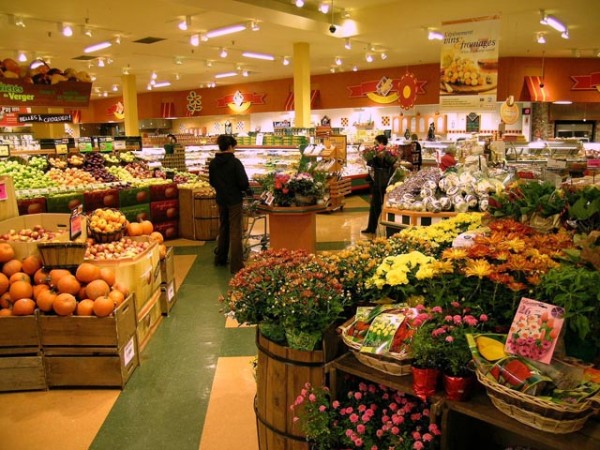Recently I saw the amazing documentary Food Inc. it opened my eyes to the strange phenomenon of grocery shopping. Food Inc.’s grocery store scene highlights the dreamlike peculiar nature of being able to find food of every kind in one place. It exposes the fact that consumers no longer care to think about where their food is coming from, or what is in it. Think about it, why is it that we can go to certain store, that has duplicates all around the country, and purchase prepackaged, brand name foods? The whole mentality of the American population is to do things conveniently, and this seems oddly too convenient. So the question is how was this prepackaged food manufactured? The truth is no one really knows the answer besides the factories that produce the stuff, and the people willing to investigate. To keep consumers in the dark, companies use scientifically manufactured ingredients with tongue twisting names and advanced machinery to create less expensive food imitations. This fine, dare I say confusing, list of scientific details on labels do a great job keeping consumers rather perplexed about what it is they’re actually purchasing. We all know that you can turn the box over and read the nutrition facts and ingredients, but that doesn’t really matter when you have no idea what the ingredients are.

One thing people have to remember when entering a grocery store is that a lot of things aren’t what they claim to be. For example; some products that say “organic” in the name are not actually USDA organic certified, therefore they may have some conventional qualities, and pesticides were probably used. Manufacturers use the word organic as a marketing ploy in the product name. Juices will claim to be 100% fruit juice in eye catching font on the front of the label but state in the fine print that it’s from concentrate or is a lower juice percentage.
So what products should you look out for specifically? One of the most common grocery store bad buys is plumped chickens. Plumped chickens are sold at a higher price because of how big they are. Poultry manufacturers “plump” chickens by injecting them with salt water, chicken stock, or seaweed extract to increase the weight, and the price. The downfall, besides paying more, is the 500% increase in sodium content. So how much money could your family be spending on salt water as a result of buying plumped chicken? According to the plumping price calculator, about $1.50 per $10 package, so if you had a 4 person household and ate chicken for two meals a week, you would be spending $50.00 a year on packaged salt water.
Another fraudulent product in grocery stores is maple syrup. A lot of labels will say “Real Maple Syrup” but if the label says the product contains high fructose corn syrup, one can deduct this is not high quality 100% real maple syrup, because all natural sugars are used to sweeten the real thing. Remember to always check the back for the ingredient High Fructose Corn Syrup. This is a fake sugar made from corn. It is nowhere near the quality of real sugar and anything containing it in general is not the highest quality because corn syrup is not real cane sugar, it is sweet syrup made from scientifically modifying corn.
More and more food frauds have been surfacing the more we inspect our products. It had been recently discovered that a lot of the fish consumers buy in the United States is mislabeled. That means consumers are paying for one fish and getting another one. The most commonly fraudulent species include; Alaskan cod, red snapper, salmon, and even catfish. The problem has adopted the name Bait and Switch, and the USDA has passed a law to attempt to control the problem. Oceana has also joined the fight against the bait and switch, they started investigating the quality of American fish provided for consumers. In their study of the city Boston, Oceana contracted the University of Guelph, in Ontario to test the DNA of 88 fish samples. During the study the university discovered 16 products mislabeled, in fact Oceana discovered while 84 percent of the seafood eaten in the United States is imported, The FDA only inspects two percent, and currently less than 0.001 percent is tested precisely for scam. On another note, recent studies have unveiled that seafood may be fraudulently mislabeled 20-70 percent of the time, especially for fish like wild salmon, red snapper, and Alaskan cod. Cons disguise these fish for species that are more abundant, and less desirable.
Consumers can avoid being scammed at the grocery store if they are simply aware of their surroundings. Make sure you’re not buying anything with extra water added, because you’re just paying for water at that point. Keep an eye out for things claiming to be something they’re not and take time to think about where the food you’re buying is coming from. Remember to investigate the country of origin, the state, and even farm that manufactures the project. Make sure to analyze fine details, such as effects of what your food is being packaged in and research what plastics and metals are harmful to things you’re consuming. Remember that the government isn’t always carefully testing or regulating for health hazards in a lot of consumer products so research things before buying them. Growing your own food is always a sure way to know exactly what you’re consuming, and buying local also tends to be safer.
By Katie Parenteau, an expert writer for KompareIt.com

